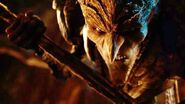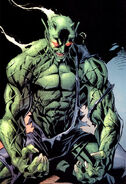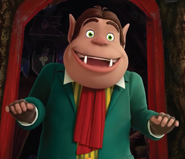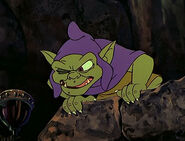(.) |
|||
| Line 35: | Line 35: | ||
===Types of Goblin=== |
===Types of Goblin=== |
||
| − | |||
'''[[Wikipedia:Pukwudgie|Puk-Wudjie]]''' |
'''[[Wikipedia:Pukwudgie|Puk-Wudjie]]''' |
||
| − | * [[ |
+ | * [[Enhanced Archery]] |
| − | * [[Death Inducement]] |
||
* [[Fire Generation]] |
* [[Fire Generation]] |
||
* [[Magic]] |
* [[Magic]] |
||
* [[Poison Generation]] |
* [[Poison Generation]] |
||
| ⚫ | |||
| ⚫ | |||
| − | *[[Dark Arts]] |
||
*[[Faery Physiology]] |
*[[Faery Physiology]] |
||
*[[Supernatural Speed]] |
*[[Supernatural Speed]] |
||
Revision as of 15:52, 27 April 2019
The power to use the abilities of goblins. Variation of Mythic Physiology. Not to be confused with Hobgoblin Physiology.
Also Called
- Gobblin/Gobeline/Gobling/Goblino/Gobbelin Form/Mimicry/Physiology
- Goblin Form/Mimicry
Capabilities
User with this ability either is or can transform into a goblin (also gobblin, gobeline, gobling, goblyn, goblino, and gobbelin), a small, ugly creatures who tend to be evil, crabby, and/or mischievous. While they're small and weak, goblins may make up for this by being clever and cunning. They may manufacture clever traps to trip up the unwary foe, or overwhelm them through sheer numbers. Either way, goblins in folklore and fantasy fiction are highly variable lot in both appearance and behavior. Generally speaking they are smallish humanoids, with pointy ears and features tending to pop up repeatedly.
A stronger form of goblin (which may or may not be conflated with the orc) may be known as a hobgoblin, though the term originally denoted the friendlier variety of goblin (the word 'hob' being derived either from the shelf at the back of a fireplace and thus indicating 'hearth and home' or from a Middle English nickname for "Robert"). English Puritans later started using the word 'hobgoblin', originally meaning a friendlier variety of goblin, to mean 'demon', which probably is why Tolkien used the word 'hobgoblin' to mean 'a bigger goblin'. This usage of the word was then propagated, by Dungeons & Dragons. While annoying, goblins are also more likely to be comedic, bumbling, or simply harder to take seriously than their bigger relatives.
A more recent trend in modern fantasy is to make them a merchant race with a unique gift for managing your money, or separating you from it. Another trend tends to give excessive interest on fire and explosives.
In folklore, goblins and especially hobgoblins were diminutive household pests, or at best wild creatures, and were typically conflated with whatever trolls and/or faeries fit the trope. If they were viewed at all as a mythical race, instead of just monsters or diminutive faeries of the nasty sort, they would be generally viewed as the "dark" version of elves or dwarves in that culture.
Applications
Variations
- Enhanced Crafting
- Enhanced Instincts
- Enhanced Intelligence
- Enhanced Thievery
- Enhanced Trapping
- Enhanced Wits
Types of Goblin
- Faery Physiology
- Supernatural Speed
- Supernatural Strength
Associations
- Faery Physiology
- Hobgoblin Physiology
- Mythic Physiology
- Trickster
Known Users
Folkore/Mythology
- Nunu sa Punso (Filipino Mythology)
- Goblins (Folklore)
Literature
- Goblins (Discword)
- Goblins (Harry Potter)
- Goblins (The Spiderwick Chronicles)
- Goblins (Tolkien)
Movies
- Goblins (Labyrinth)
- Goblins (Legend)
- Blix
- The Oomps (Little Nemo: Adventures in Slumberland)
- Creeper (The Black Cauldron)
- Goblins (The Hobbit: An Unexpected Journey)
- Green Goblin (Spider-Man: Into the Spider-Verse)
Cartoons
- Aziz (Aladdin: The Animated Series)
- Mountain Goblins (American Dragon: Jake Long)
- Goblins (Strange Magic)
- Bog King
- Griselda
- Morris (Sofia the First)
- Goblins (Trollhunters)
Comics
- Harold Osborn/Hobgoblin (Marvel Comics)
- Norman Osborn/Green Goblin (Marvel Comics)
Manga/Anime
- Goblimon and variants (Digimon)
- Goblins and variants (Goblin Slayer)
- Kollekio (Marchen Awakens Romance)
- Goblins (Re:Monster)
Tabletop Games
- Goblins (RPGs)
Video Games
- Goblin Tinkerer (Terraria)
Other
- SCP-2523-1 - Goblin Market (SCP Foundation)














